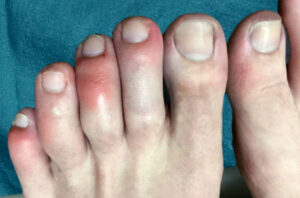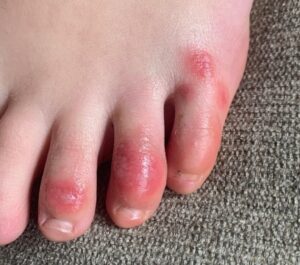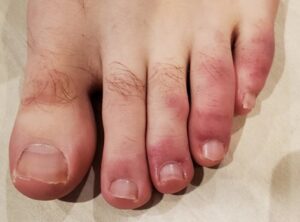


One of the strangest of skin conditions now recognized by the American Academy of Dermatology as a likely symptom of COVID-19 infection has been dubbed “COVID toes”. COVID infection has been implicated as the cause of a number of skin changes, but COVID toes stand out as a particularly distinct and strange manifestation. Visually, the condition refers to a patient’s toes becoming swollen and developing red or pink bumps and lesions which sometimes turn purple.
Some doctors have referred to COVID toes as “pernio-like” due to the skin condition’s resemblance to pernio. Pernio, also sometimes called chilblains, is a skin condition caused by exposure to cold temperatures and is characterized by blistering, swelling, and discoloration on the feet. However, unlike Pernio, scientists do not currently believe COVID toes are caused by low temperatures.
What Causes COVID Toes?
If COVID toes are not caused by low temperatures like pernio, then what is causing the condition? Experts aren’t certain, though a few hypotheses have been put forward. COVID toes could be the result of the inflammation of toe tissue, the inflammation of blood vessel walls, the formation of small blood clots, or a combination of one or more of these potential causes.
As more and more reports become available, physicians and pathologists are observing microthrombi (clots) within the small blood vessels when skin samples are examined under the microscope. This is different than what is observed in pernio. Experts feel these microthrombi are contributing to the toe skin changes, even in the absences of severe infection.
Which Patients Get COVID Toes?
Interestingly, unlike many of the more dangerous symptoms of COVID, COVID toes are more common in younger, rather than older patients. Children, adolescents, and individuals in their 20s and 30s seem most at risk for the skin condition.
Are COVID Toes Associated With Other Symptoms?
Based on currently available information, COVID toes generally appear around the same time or after other COVID symptoms begin to manifest. However, COVID toes have also been observed in some asymptomatic patients as well. As case reports accumulate, many physicians are noting COVID toes to be a late finding. That is, many patients are over the illness (and many never knew they had it) when these skin changes present.
How Can A Doctor Tell If I Have COVID Toes?
Your doctor may order a number of tests. If available and deemed appropriate, these might include:
- Covid PCR swab
- A Complete Blood Count with differential
- Anti-Nuclear Antibody
- Rhematoid Factor
- Cold agglutinins
- Cryoglobulins
- Complement (C3/C4/CH50)
- C-Reactive Protein/Erythrocyte Sedimentation Rate
- d-dimer
- Fibrinogen
- Anti-Phospholipid Antibody
- skin biopsy
- Covid IgM and IgG
Covid PCR may be negative in patients presenting with COVID toes. Still, these tests can help rule out other conditions that can mimic Covid toes, as well as give insight into a person’s health in those infected with the virus. In the end, contact history, clinical suspicion and supportive testing help physicians make this diagnosis.
Should COVID Toes Be Treated?
At this time, treatment of the skin changes is only recommended if they are bothersome or symptomatic. Many dermatologists are recommending and 81 mg baby Asprin (in individuals over 16 years of age) and topical Clobetasol steroid. Of course, confirmation of COVID toes is important to ensure the patient is not at risk for other disease sequelae, contact tracing and to prevent the spread of the disease.
What Should You Do If Your Toes Develop A Skin Condition Resembling COVID Toes?
For individuals who suddenly begin to notice skin changes on their toes or digits which resemble COVID toes, it is important to remain calm. You should contact your primary care doctor or a dermatologist to have an expert evaluate if these changes could indeed a symptom of COVID, rather than another skin condition entirely. They will direct you in how to be tested if it is suspected your skin condition could be COVID toes.
Previous Post Next Post